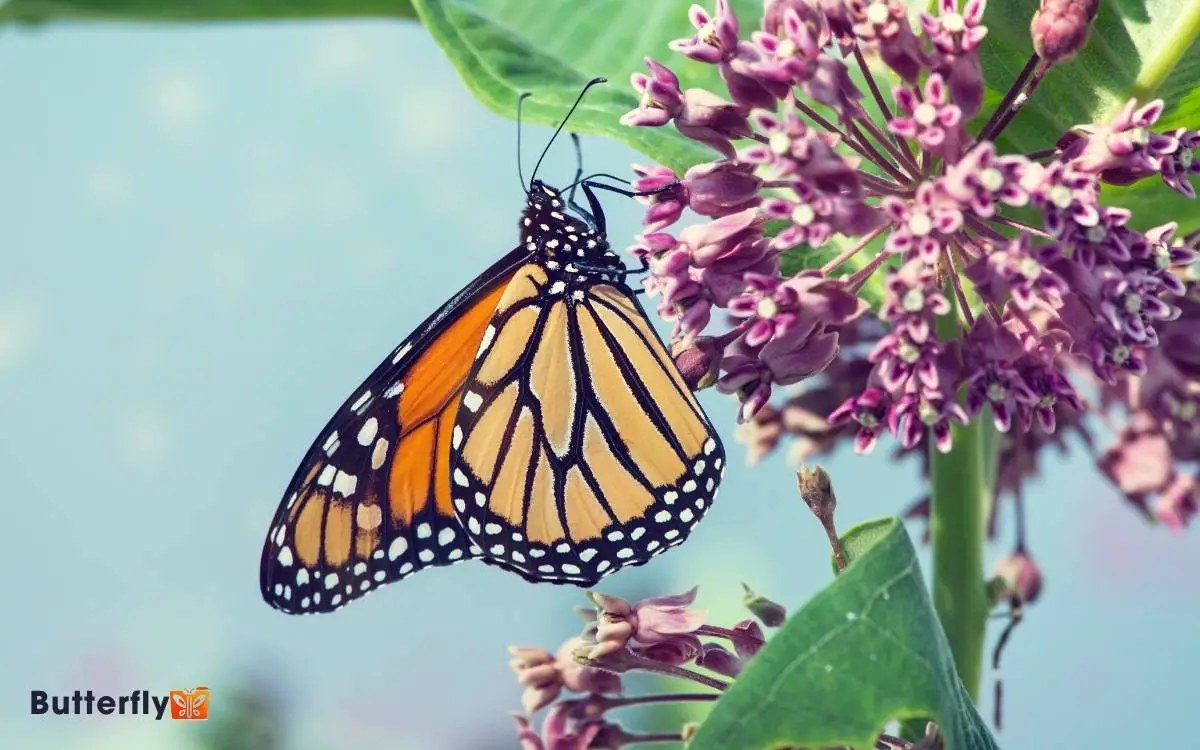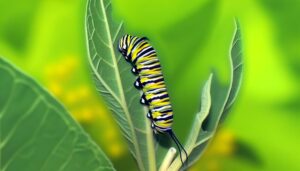Adaptations of the Monarch Butterfly: Key Survival Traits!
You’ll notice the Monarch butterfly exhibits bright orange and black aposematic coloration, a clear warning to predators of its toxicity, derived from cardenolides consumed from milkweed.
They undertake a remarkable migration spanning up to 3,000 miles, relying on environmental cues and magnetoreceptors. Monarchs depend exclusively on milkweed for egg-laying and larval food, illustrating a highly specialized breeding cycle.
Thermal regulation through sunbathing maintains an internal temperature of 30-35°C. Overwintering strategies include clustering, fat storage, and dormancy.
High genetic diversity, with polymorphism around 15%, enhances their survival against pathogens. Explore further to understand these incredible adaptations in detail.

Key Takeaways
Warning Coloration
Monarch butterflies exhibit bright orange and black warning coloration, which serves to deter predators by signaling their toxicity.
The vivid orange hue, coupled with stark black veins and white spots on their wings, creates a high-contrast pattern easily recognizable.
You can observe that the orange pigmentation, derived from carotenoids, spans approximately 9 cm² per wing. This aposematic coloration is an evolutionary adaptation enhancing survival rates by reducing predation.
When you study these butterflies, you’ll notice their coloration remains consistent across various populations, underscoring its critical role.
The wings’ reflective properties also amplify visibility in diverse lighting conditions, ensuring that their warning signal is effective both in dense foliage and open fields. This distinct coloration is a primary defense mechanism.
Toxicity to Predators
Their vivid coloration is not just for show; it directly correlates with their chemical defenses, as these butterflies accumulate toxic compounds called cardenolides from the milkweed plants they consume during their larval stage.
You’ll notice that cardenolides make monarchs unpalatable to many predators, specifically birds. When a predator ingests a monarch, it often induces vomiting and a learned aversion.
| Predator | Reaction to Monarch Ingestion |
|---|---|
| Blue Jay | Vomiting, aversion |
| Black-headed Grosbeak | Reduced sensitivity, occasional consumption |
| Mice | Avoidance after first taste |
You can see how these reactions help monarch populations thrive despite predation pressures. Their toxicity, measured in micrograms of cardenolides per gram of body weight, is a critical survival mechanism.
Long-Distance Migration
In a remarkable display of endurance and navigational prowess, these butterflies undertake a yearly migration spanning up to 3,000 miles.
You’ll find that monarchs rely on a combination of environmental cues and an innate biological compass. Utilizing the sun’s position, they maintain their southward trajectory from North America to central Mexico.
Monarchs also possess magnetoreceptors, allowing them to sense Earth’s magnetic field, which aids in orientation.
During this journey, they travel at speeds of approximately 5 miles per hour and can cover up to 100 miles in a single day. Their wings, adapted for long flights, undergo minimal wear due to their efficient flight mechanics, enabling them to survive this arduous trek.
Understanding this migration reveals the incredible adaptability of monarch butterflies.
Seasonal Breeding
Each spring and summer, monarch butterflies engage in a precisely timed breeding cycle that aligns with the availability of milkweed, their larval host plant.
You’ll observe that female monarchs lay eggs exclusively on milkweed plants, guaranteeing larvae have immediate access to food.
Typically, a female can lay between 100 to 300 eggs over a two to five-week period. The eggs hatch within 3 to 5 days, and caterpillars undergo five instars before pupating.
Here’s a quick look at their reproductive cycle:
| Stage | Duration | Description |
|---|---|---|
| Egg | 3-5 days | Laid on milkweed leaves |
| Larva | 10-14 days | Passes through five instars |
| Pupa | 8-15 days | Metamorphosis into an adult butterfly |
This cycle guarantees monarchs thrive during peak milkweed growth.
Milkweed Dependency
Monarch butterflies rely heavily on milkweed plants not only for egg-laying but also as the sole food source for their larvae.
You’ll find that female monarchs specifically seek out milkweed (genus Asclepias) to deposit their eggs. This is essential because monarch larvae, or caterpillars, exclusively consume milkweed leaves.
Milkweed contains cardenolides, toxic compounds that the larvae ingest and store, providing them with a chemical defense against predators.
Without milkweed, monarch larvae can’t survive. Detailed observations show that larvae will consume approximately 200 square centimeters of milkweed foliage during their development.
You should also note that monarch populations are closely tied to the availability of milkweed, making habitat conservation crucial for their survival.
Camouflage in Larvae
Camouflage plays a critical role in the survival of monarch larvae, as their striped black, white, and yellow coloration helps them blend seamlessly with the milkweed leaves they inhabit.
This coloration disrupts the outline of the larvae, making it difficult for predators to detect them. The effectiveness of this camouflage is evident when you observe the larvae against the variegated leaves and stems of the milkweed plant.
| Observation | Description |
|---|---|
| Coloration | Black, white, and yellow stripes |
| Habitat | Milkweed leaves and stems |
| Camouflage Effectiveness | High due to disruptive coloration |
When you examine these larvae closely, you’ll notice how their coloration mimics the light and shadow patterns on the leaves, providing significant protection from avian predators.
Rapid Reproduction
You’ll find that Monarch butterflies exhibit rapid reproduction through a frequent breeding cycle, typically occurring every 4-5 weeks.
Each female can lay up to 500 eggs, strategically distributing them across multiple milkweed plants.
The eggs hatch within 3-5 days, and the larvae experience a rapid growth rate, reaching full maturity in approximately 10-14 days.
Breeding Cycle Frequency
In examining the rapid reproduction of monarch butterflies, you’ll find that they can complete a breeding cycle in as little as four weeks under ideal conditions.
This swift generational turnover is facilitated by several key factors:
- Optimal Temperatures: Monarchs thrive and reproduce rapidly in temperatures ranging from 21°C to 29°C.
- Abundant Milkweed: Milkweed serves as both the primary food source for larvae and the oviposition site for females, ensuring a continuous supply.
- Photoperiod Sensitivity: Monarchs respond to increasing daylight hours, which triggers reproductive behaviors and accelerates development.
These conditions collectively enable monarchs to maximize their reproductive output, ensuring population sustainability.
Such rapid cycles not only aid in species survival but also enhance their ability to adapt and evolve in response to environmental changes.
Egg Laying Patterns
Monarch butterflies exhibit distinct egg-laying patterns, often depositing their eggs singly on the underside of milkweed leaves, guaranteeing optimal larval survival.
You’ll find each egg is meticulously placed to minimize competition and predation.
The female monarch, using her specialized ovipositor, lays between 300 to 500 eggs over two to five weeks. Each egg measures approximately 1.2 millimeters in height and 0.9 millimeters in diameter.
This strategic dispersal maximizes the likelihood of offspring reaching maturity. The eggs hatch within 3 to 5 days, depending on ambient temperature.
By choosing milkweed, the female ensures that newly hatched larvae have an immediate food source, crucial for their growth. This rapid reproduction strategy is essential for overcoming high mortality rates in the wild.
Larval Growth Rate
Rapid larval growth in monarch butterflies hinges on the larvae’s ability to consume large quantities of milkweed, their primary food source, within a short period.
You’ll notice that monarch larvae, or caterpillars, can grow up to 2,700 times their initial mass in just 10-14 days. This rapid growth is essential for their survival and subsequent transformation into butterflies.
Key observations include:
- Feeding Frenzy: Each larva devours approximately 200 mg of milkweed daily.
- Growth Stages: They pass through five instars, molting between each stage to accommodate their expanding size.
- Nutrient Absorption: Efficient digestion and absorption of milkweed’s toxic compounds, which makes them distasteful to predators.
This accelerated growth cycle exemplifies the monarch’s remarkable adaptation strategy.
Overwintering Strategies
Have you ever wondered how Monarch butterflies manage to survive the harsh winter months? You’ll find their overwintering strategies fascinating.
Monarchs migrate to specific locations with precise environmental conditions, often traveling up to 3,000 miles. They congregate in dense clusters, which helps conserve heat and protect them from predators.
Here’s a brief overview:
| Strategy | Details |
|---|---|
| Migration | Travel up to 3,000 miles |
| Cluster Formation | Congregate in dense clusters |
| Habitat Selection | Choose areas with stable temperatures around 10°C |
| Fat Storage | Accumulate lipids during the larval stage |
| Dormancy | Enter a state of diapause to conserve energy |
These meticulously honed strategies enable Monarchs to withstand winter’s rigors and emerge ready to reproduce in spring.
Thermal Regulation
Understanding how Monarch butterflies regulate their body temperature is key to appreciating their remarkable adaptations for survival.
You’ll notice that these butterflies employ several strategies to maintain ideal thermal conditions.
- Sunbathing: Monarchs bask in the sun, spreading their wings to absorb solar radiation, which raises their body temperature.
- Shivering: They generate heat by shivering their flight muscles, a process observed when ambient temperatures fall below 13°C (55°F).
- Microhabitat selection: Monarchs seek microclimates like sunlit patches or sheltered spots to escape extreme cold or heat.
These behaviors ensure that internal temperatures stay within the 30°C-35°C (86°F-95°F) range, critical for metabolic processes and flight activity.
Predator Avoidance
You’ll notice the Monarch butterfly‘s vibrant orange and black wings, an aposematic coloration strategy that warns predators of toxicity.
By consuming milkweed plants, Monarchs incorporate cardenolides into their bodies, making them poisonous to many birds.
Additionally, they employ mimicry and camouflage to further evade predation, blending into their surroundings or mimicking other toxic species.
Aposematic Coloration Strategy
Exhibiting a striking combination of bright orange and black, the Monarch butterfly’s aposematic coloration serves as a potent warning signal to potential predators about its unpalatability.
You’ll notice that this vivid coloration isn’t just for show. It’s a survival mechanism honed over generations, effectively reducing predation.
Consider the Monarch’s appearance:
- Brilliant orange wings: Measuring approximately 10 cm across, these wings act like flashing neon signs in the natural world.
- Bold black borders and veins: These create a high contrast, making the orange even more noticeable.
- White spots on black margins: These spots add another layer of visual complexity, making the butterfly unmistakable.
This visual strategy deters predators, ensuring that the Monarch’s striking appearance is synonymous with a bad dining experience.
Toxic Milkweed Diet
How do Monarch butterflies bolster their defense against predators?
They consume milkweed plants, which contain toxic compounds called cardenolides. By ingesting these chemicals, Monarch larvae accumulate toxins in their tissues, rendering them distasteful to potential predators.
The concentration of cardenolides is measured in micrograms per gram of body weight, with Monarchs often reaching levels that deter even the most determined predators.
Cardenolides specifically disrupt the sodium-potassium pump in animal cells, causing severe physiological reactions in predators that attempt to eat the butterflies.
This biochemical defense is so effective that a single encounter with a toxic Monarch can train a predator to avoid any butterfly with similar coloration. Thus, the toxic milkweed diet is a pivotal adaptation for Monarch survival.
Mimicry and Camouflage
Monarch butterflies employ mimicry and camouflage to enhance their survival by deceiving predators and blending into their environment.
By resembling the viceroy butterfly, which is also unpalatable, they benefit from Batesian mimicry. This deception is essential for avoiding predation.
Monarchs also use their surroundings to their advantage:
- Wing coloration: Their bright orange and black patterns not only signal toxicity but also provide camouflage against certain backgrounds.
- Resting behavior: By positioning themselves on similarly colored foliage, they reduce visibility to predators.
- Seasonal changes: During migration, monarchs’ coloration helps them blend with the autumnal hues, providing additional concealment.
These adaptations allow monarchs to effectively avoid predators and increase their chances of survival, ensuring their continued presence in diverse ecosystems.
Genetic Diversity
Genetic diversity within monarch butterfly populations is essential for their adaptability to environmental changes and disease resistance.
You’ll notice that genetic variation allows monarchs to exploit a wide range of habitats and food sources.
Studies show a genetic polymorphism rate of approximately 15%, enabling some individuals to survive extreme weather or pathogen pressures better than others.
You can observe that populations with higher genetic diversity have greater resilience against parasites such as *Ophryocystis elektroscirrha*.
When genetic variation is reduced, monarchs face increased risks of inbreeding depression, leading to decreased survival rates.
Hence, conserving diverse habitats and promoting gene flow between populations are pivotal for maintaining monarch genetic diversity and their long-term survival.
Conclusion
In understanding the monarch butterfly’s adaptations—its striking warning colors, toxicity, and remarkable migration you’ve glimpsed nature’s ingenuity.
Imagine the precision: seasonal breeding timed with milkweed cycles, intricate overwintering strategies, and thermal regulation that guarantees survival.
Each adaptation, like a finely tuned instrument, plays its part in the symphony of life.
You see, their genetic diversity isn’t just fascinating; it’s a proof of resilience.
So, next time you spot a monarch, remember, it’s a marvel of evolutionary perfection.







What’s Going down i am new to this, I stumbled upon this I’ve discovered It absolutely useful and it
has aided me out loads. I’m hoping to contribute & assist other customers like its helped me.
Great job.
my web-site :: Buy SEO Backlinks
Hi, i think that i saw you visited my site thus i
came to “return the favor”.I am attempting to find things to enhance my web site!I suppose
its ok to use a few of your ideas!!
Feel free to surf to my website 3-Tier Backlins Pyramid
Quality posts is the key to be a focus for the visitors to pay a visit the web site,
that’s what this web site is providing.
Also visit my webpage Cheap Private Proxies
Very good info. Lucky me I recently found your blog by chance (stumbleupon).
I have book-marked it Proxies For Senuke later!
Pretty great post. I just stumbled upon your blog and wished to say that
I have truly enjoyed browsing your weblog posts. After all I’ll be subscribing in your feed and I
am hoping you write again very soon!
my homepage: cheap usa Private proxies
What’s up, I read your blog on a regular basis. Your humoristic style
is awesome, keep doing what you’re doing!
My blog post … Dedicated Private Proxies For Sale
I relish, result in I discovered exactly what I used to be taking a look for.
You’ve ended my 4 day lengthy hunt! God Bless you man. Have a great day.
Bye
Here is my blog post … Proxies Deals
Hi everyone, it’s my first pay a quick visit at this web site, and paragraph is genuinely fruitful in favor of me, keep up posting these articles.
Also visit my web page; Best Proxy
I was able to find good advice from your articles.
Visit my website; Proxies Cheap
I always spent my half an hour to read this website’s content every
day along with a cup of coffee.
My web-site Buy 100 Proxies
Hi outstanding website! Does running a blog like this
require a great deal of work? I have very little knowledge of computer programming but I
was hoping to start my own blog soon. Anyhow, should you have any ideas
or tips for new blog owners please share. I know this is off topic but
I simply needed to ask. Appreciate it!
Take a look at my web blog :: 5000 Cheap Proxies
wonderful points altogether, you just received a new reader.
What would you suggest in regards to your submit that
you made a few days ago? Any certain?
Feel free to visit my webpage … 100 Private Proxies
Hello mates, fastidious post and pleasant arguments commented
at this place, I am truly enjoying by these.
Here is my site Buy Proxy Ipv6
Thanks for finally talking about > Adaptations Of The
Monarch Butterfly: Key Survival Traits! Buy 400 Cheap Proxies
Have you ever considered publishing an ebook or guest authoring on other websites?
I have a blog based upon on the same topics you discuss and would
really like to have you share some stories/information. I know my viewers would
enjoy your work. If you are even remotely interested, feel free to shoot me an e mail.
Also visit my web page – nordvpn coupons inspiresensation
Absolutely, at Buy Steroids Canada, we only inventory
the very best quality products which have gone through rigorous testing.
After confirming your order, you’ll be redirected to the payment
page, and depending in your cost methodology, you’ll be redirected to the trusted and safe fee portal of your selection. As Quickly As your payment has been processed, you’ll mechanically receive
an immediate notification that the order has been profitable.
In some circumstances, depending on the cost technique, our
team may have to manually approve your order. Upon receipt
of cost, we’ll provide you with the postal monitoring codes,
usually within 2-5 enterprise days.
Many on-line peptide corporations, like Amino Asylum, pride themselves on providing high
quality products at inexpensive prices. This aggressive pricing, combined with occasional reductions and promotions, can make
on-line buying more economical. On-line peptide distributors
often provide a broad range of products, from varied peptides
to blends, catering to completely different needs. This variety ensures that customers can find particular peptides that might not be available in native
stores. They additionally present blends of products like this CJC 1295
with the appropriate GHRP-6.
The solely actual disadvantage they have as a vendor is the fact that they don’t present any reviews on their website.
For that you’ll should pop over to Reddit, however, when you’re there you’ll not be disappointed.
The anecdotal evidence matches perfectly with their
imaginative and prescient of superior-quality peptides. Regardless Of being a newcomer,
Core Peptides has already made a positive impression on lots of its prospects.
Their dedication to transparency and the highest
quality management is clear of their promise to make COAs obtainable for all merchandise very
quickly. In fact, they are continuously including new exams to their present repertoire to
make certain that their products meet the very best standards potential.
Follow recommended biking protocols to reduce unwanted effects and stop long-term health issues.
While good suppliers exist, do not forget that
that is somewhat of an underground scene-so adhering to real pharmaceutical
requirements is essential. This is by far one of the
best supply I’ve used and I am certain as hell that I won’t ever change sources
again. This man whose father labored in sari shop, married 10-year-old girl at 21, later turned
out to be one of most famous mathematicians, however misplaced
life at just 32, he was… Pakistan makes
new provides in third try and promote PIA, lure patrons
by offering a stake of… We guarantee the supply of
verification codes on all our products. The parcel might be sent by way
of mail to any handle you prefer, but we don’t specify a return mail handle; so if you don’t receive or accept the parcel,
it’s going to essentially be lost.
You must be very cautious when injecting the drug
as a outcome of it might include nasty unwanted effects.
It is usually supposed for experienced bodybuilders who’re familiar with the consumption and dosing of the
drug. The cycling pattern involves taking steroids for a given interval of weeks to months then stopping for a given period then resuming later.
Different individuals stack the steroids that are
they take a mixture of anabolic steroids. For occasion, a mixture of orals and injectables is aimed to enhance the end result.
Our merchandise are vacuum sealed to make sure safety, sterility, and especially incomparable discretion. We ship the merchandise
with their authentic packaging and instructions.
Pregnant girls and breastfeeding moms should keep away from taking any bulking or
slicing dietary supplements. Who can blame us, given the history of muscle-building supplements, we thought this was simply one other snake oil or something far worse.
And in the last couple years, that includes testosterone, which
is simpler to get than ever before. These revolutionary companies deliver testosterone dietary supplements straight to your door.
You don’t essentially need to use your individual name when buying,
however in case you are picking up from the publish workplace this
could be a problem as a result of they require ID.
Solely in excessive cases will you be needed to consult
with the doctor. You may contact somebody from the actual same fitness center to confirm whether
or not what you’ve learn online corresponds to the details of the steroids they’re using.
However, talking with a medical official or someone in an analogous career is far preferable.
This characteristic is price contemplating when buying steroids online to avoid coping with nasty side effects.
Most sportsmen and girls choose Getmassive merchandise when transitioning
between cycles as a end result of their steroid merchandise are extremely clean. The
online steroid market has developed significantly lately.
On the other hand, authorized steroid alternatives are thought of safer options for
these trying to improve their bodily performance and construct muscle mass.
They work by using pure ingredients to stimulate the body’s
hormone production and metabolic processes, thereby encouraging muscle development and fats loss.
Moreover, authorized steroid alternate options are simply
accessible, as they are often bought legally and not utilizing a prescription. interesting facts about
steroids (Jbhnews.Com), significantly anabolic steroids, have become more and more in style in the UK amongst athletes, bodybuilders, and people looking to improve their physical look and performance.
However, the method of buying steroids in the UK is ruled
by strict laws and regulations designed to ensure security and
forestall misuse. This information aims to provide an in depth
overview of buying steroids in the UK, including legal
concerns, kinds of steroids available, sources, dangers, and greatest practices.
As with any nation, the UK has stringent laws governing the sale, possession,
and use of anabolic steroids.
Nonetheless, over the past 5 years of operation, 99% of orders have reached our customers.
Common members qualify for up to a 30% discount
per order on certain merchandise and turn into eligible for our prize draws.
Our achievement network includes a multitude of courier and success partners to ensure your order
is correctly packaged and delivered speedily and safely.
Our product choices are continuously up to date based on new superior developments in the sports activities pharmacy trade, no matter which nation they are produced in.